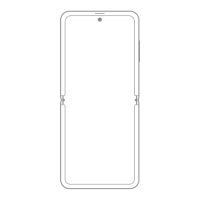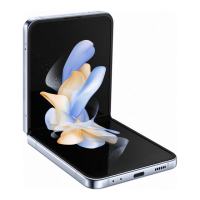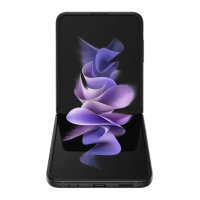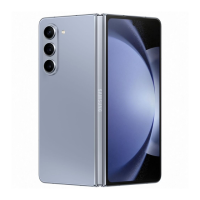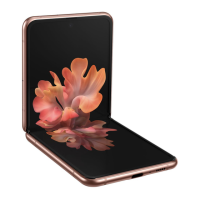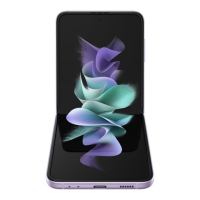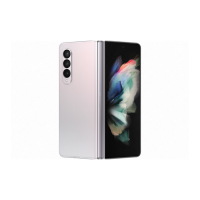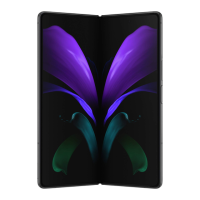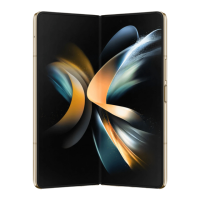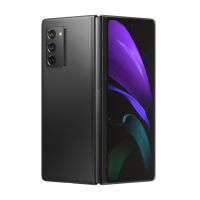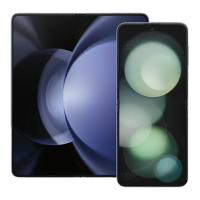
Do you have a question about the Samsung Galay Z Flip5 and is the answer not in the manual?
| RAM | 8 GB |
|---|---|
| Operating System | Android 13, One UI 5.1.1 |
| Dimensions (Unfolded) | 165.1 x 71.9 x 6.9 mm |
| Dimensions (Folded) | 85.1 x 71.9 x 15.1 mm |
| SIM | Nano-SIM, eSIM |
| Loudspeaker | Yes, with stereo speakers |
| Bluetooth | 5.3, A2DP, LE |
| NFC | Yes |
| USB | USB Type-C 3.2, OTG |
| Sensors | Fingerprint (side-mounted), accelerometer, gyro, proximity, compass, barometer |
| Colors | Mint, Graphite, Cream, Lavender, Gray, Blue, Green, Yellow |
| Announced | 2023, July 26 |
| Status | Available. Released 2023, August 11 |
| Display (Main) | 6.7 inches, Foldable Dynamic AMOLED 2X, 120Hz, HDR10+, 1200 nits (peak) |
| Display (Cover) | 3.4 inches, Super AMOLED |
| Processor | Qualcomm Snapdragon 8 Gen 2 (4 nm) |
| Storage | 256GB, 512GB |
| Rear Camera | 12 MP, f/1.8, 24mm (wide), 1/1.76", 1.8µm, Dual Pixel PDAF, OIS + 12 MP, f/2.2, 123˚ (ultrawide), 1.12µm |
| Front Camera | 10 MP, f/2.2, 1.22µm |
| Battery | 3700 mAh |
| Charging | 25W wired, 15W wireless, 4.5W reverse wireless |
| Weight | 187 g |
| Build | Glass front (folded), plastic front (unfolded), glass back (Gorilla Glass Victus 2), aluminum frame |
| Wi-Fi | Wi-Fi 802.11 a/b/g/n/ac/6e, dual-band, Wi-Fi Direct |
| Positioning | GPS, GLONASS, GALILEO, BDS |
| Water Resistance | IPX8 |
| Models | SM-F731B, SM-F731U, SM-F731W |
Details the physical layout and usage modes like Folded and Flex for Fold5/Flip5.
Guides through initial setup, data transfer, and basic operation.
Covers home screen customization, S Pen, Bixby, and other core features.
Capturing photos/videos, navigation, features, and settings for Fold5/Flip5.
Managing, editing, and sharing media files; taking screenshots and screen recordings.
Selecting and customizing camera shooting modes for optimal results.
Configuring various camera settings for intelligent features, pictures, and selfies.
Managing apps, including uninstalling, searching, and creating folders.
Overview of preloaded and downloadable applications from major providers.
Methods for opening and navigating the device settings menu.
Managing network connections like Wi-Fi, Bluetooth, NFC, and Airplane mode.
Controlling device sounds, vibrations, and audio effects.
Managing app alerts, sorting notifications, and customizing pop-up styles.
Configuring screen brightness, timeout, font size, and other display settings.
Securing the device and protecting data with a screen lock.
Managing location services, app permissions, and improving location accuracy.
Optimizing performance, managing battery, storage, and software updates.
Configuring device language, input methods, and text-to-speech.
Checking for software updates and resetting device settings.
Configuring settings for vision, hearing, dexterity, and spoken assistance.
Reviewing device information, status, and software versions.
